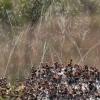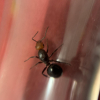What is the relationship between the Nearctic and Palearctic members of the Formica rufa group?
Is the proposed relationship based on morphology and habit of mound building?
Have genetic tests been used to confirm the relationship?
Reviewing background literature leads me to believe that it is probably assumed, by most, that there was dispersal via beringia, during the pleistocene. So the "mound building syndrome" evolved once and spread, similar to the army ant syndrome. However, I'm aware that the nest weaving ant syndrome is known to have been converged upon multiple times.
Thanks!






















